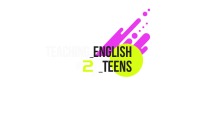MODULE 3
Gamification
Introduction to the course from course
co-author Nina Krasylova
Hello Everybody!
I’m Nina Krasylova and I’m a co-author of the #Teaching_English_2_Teens course and I’d like to assist you throughout the Module 3 of it – Gamification.
Before we start, I would like to ask you a few questions.
- Do you like playing games?
- Do you use an avatar instead of your real picture on the social network sites?
- Do you participate in loyalty programs of different shops?
- Are you an owner of a fitness bracelet or smart watch which pushes you to be active, to move more and sleep properly?
- Do you have a fitness application on your smart phone which makes you follow the program or drink proper number of glasses of water daily?
If your first answer is «no» but at least once you said «yes» answering the rest of the questions, then you are certainly engaged with gamification.
How many of your teenage learners play games?
I believe, the answer is «Almost all of them».
Do your teen students like lessons and learning? Well, I guess some of them if they are not exceptionally motivated group of learners, which happens not so often.
And the major question here is: How to make so motivated players become not less motivated learners?
What can help you?
The answer is Gamification!

Unit 1: To play or not to play?
As some research claims games help motivate students to participate more actively, develop their social and emotional intelligence and teach them to take risks. As an educator I should admit that the role of games is hard to overestimate as it is a natural way of learning.
As a teacher who works with teenagers, I understand that games for the sake of games will hardly work but if they are used effectively with the big idea in mind, they can be valuable tools for achieving the best results.
In the first unit of this module, you will learn what gamification is, you will consider pros and cons of using game elements in your lessons to benefit your teens’ learning and identify the cases when applying game components, mechanics and dynamics is not appropriate.
In a nutshell, this unit could help you reflect on your own experience connected with games, learn about more effective ways of using them in a more player-friendly mode.
LECTURE

READING
Unit 2: Best gamification examples
Do you know how to make your classroom atmosphere more learner and learning-centered?
Most students react very positively toward gamification. Some students that have very low grades and perform poorly in lessons, get the chance to shine by doing small tasks and gain points which are not possible in the traditional grading system.
For example, students who bring the books every week or post home assignment on time and show responsibility can be rewarded with XP (experience points). Students who help their friends get a badge, which has high XP value that is added to their total score. Sounds weird for a traditional classroom environment? Not at all. By viewing the leaderboard (progress bars), students feel competitive and push themselves a bit harder than normally. By using game elements in education (NOT actual games), we can motivate our students to improve their achievements. By using a very practical implementation of gamification, anyone can increase motivation, create positive competition, more fun and hence, increase the performance.
Let’s have a closer look at how to make it possible.
LECTURE

READING
Test for module 3
Leave a comment to course developers
